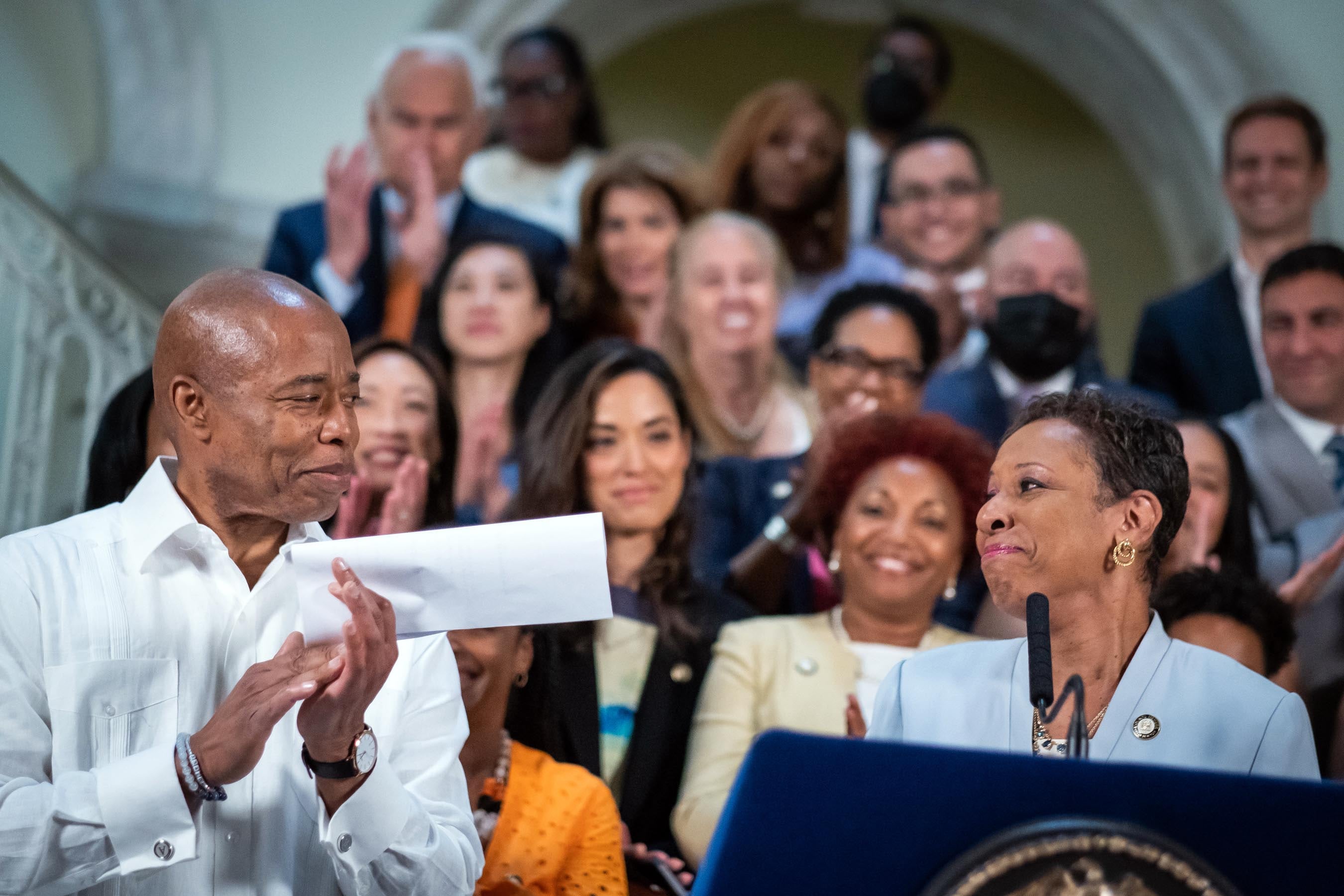New York City lawmakers reached a $101 billion budget deal Friday that finalizes cuts to school budgets for the 2022-2023 school year.
Many details of the agreement, which sets the city’s financial plan from July 1 through June 2023, were still unavailable Friday evening. But in April, the mayor’s proposal showed a $1 billion drop for the education department, to just under $31 billion — largely because federal coronavirus relief is beginning to dry up. That budget is made up of state, federal, and city funding, and under Adams’ proposal, the city would boost its own spending on education by about $720 million.
Mayor Eric Adams and the City Council were expected to reach a deal this week. But, Politico reported that an 11th hour disagreement developed over cuts to individual school budgets after school and union leaders decried the decreases, which they saw for the first time this week.
Those cuts were announced in February, but they made it into the final budget.
The cuts, totaling $215 million across all schools this year, represent a reversal of a policy over the past two years, which covered schools financially for enrolling fewer students than expected halfway through the year, during the pandemic.
While schools will see a drop in funding compared to this year’s budgets, Adams would not call them cuts.
“We had a major drop in student population in the [department of education], so what we’re doing — we are not cutting, we are adjusting the amount based on the student population,” Adams told reporters after a ceremonial handshake with Council Speaker Adrienne Adams.
Separately, the budget also sets aside $2 billion in coronavirus relief funds for next school year and expands summer programming for children and young adults.
Here are some highlights from Thursday’s budget agreement:
School budgets
Many schools will see smaller budgets due to the city’s projections of declining student enrollment, which has dropped by 6.4% since the pandemic’s start in 2020.
For the first time since the beginning of the pandemic, schools will be funded in a way that’s more closely tied to their enrollment, but school and union leaders are worried about the impact of the cuts on students and staff.
Before the pandemic, schools were required to send money back to the education department if, by halfway through the year, they had enrolled fewer students than originally projected.
To blunt the financial blow on schools during the pandemic, Mayor Bill de Blasio spent $177 million — 75% of which came from federal coronavirus relief dollars — to cover budgets for 870 schools that saw mid-year enrollment drops. Again this year, the administration spent $324 million to forgive mid-year enrollment drops at 1,200 schools, again with roughly three-quarters covered by stimulus dollars.
In February, Adams announced he wanted to reverse this policy and gradually cut budgets over the next two years. Using federal stimulus dollars to backfill the cuts, Adams plans to cut school budgets by $215 million this fall, just under $300 million for the 2023-2024 school year, and finally $375 million in 2024-2025.
“We are in a very dangerous time that many people are not realizing,” Adams said. “We are dropping students so much.”
Fewer students could mean a need for fewer teachers. But reduced funding complicates plans that principals had for their schools, such as launching new programs or hiring new staff. The city is also facing a new state law requiring New York City to reduce class sizes, but officials have not explained how they’ll reconcile the new mandate with cuts to school budgets.
Principals are also worried they may need to “excess” staff, meaning those staffers would leave the school and could look for jobs elsewhere in the system. If unsuccessful, those staffers could enter the Absent Teacher Reserve, where they still get paid.
Asked how the city devised enrollment projections, a City Hall spokesman said officials calculate them based on recent trends in each grade level from kindergarten through 12th grade. Principals, superintendents, and other education officials who work with schools “review and provide significant feedback” before enrollment projections are finalized.
The plan received blowback from educators and some city officials.
Comptroller Brad Lander said the city must address enrollment drops, but schools should not see cuts yet as schools emerge from the pandemic. He also suggested the city should revisit the Fair Student Funding formula, which is based on enrollment projections but also sends more money to schools with high shares of students with disabilities, learning English as a new language, or facing academic struggles. The city has plans to begin reviewing the formula this year — a process that happened once before in 2019 but never resulted in changes.
“Our schools have endured the hardest two years and need every penny to provide the social, emotional, and academic supports that all our students deserve this summer and fall,” Lander said in a statement.
COVID stimulus spending
The administration plans to spend about $1.8 billion in COVID stimulus money next school year. City schools received about $7 billion in stimulus money, of which $2 billion has been spent through the first week of May, according to City Hall.
While hundreds of millions of dollars went directly to schools this year to create academic recovery programs, some schools struggled to spend the money because they couldn’t recruit teachers to work overtime to staff tutoring programs. Roughly a third of the city’s students with disabilities were expected to have received stimulus-funded recovery services by the end of this school year.
About $160 million will go toward softening the blow of enrollment declines for schools (leading to the overall $215 million cut for next year). Another $125 million is expected to go directly to schools for “academic recovery” and arts instruction, with more funds slated for schools with higher needs students. Schools must use the money to provide academic intervention and additional support for students learning English as a new language.
The mayor’s executive budget proposed some other initiatives to be covered by COVID stimulus dollars, including $176 million for Summer Rising, the city’s universal summer enrichment program.
Summer programming and community schools
The budget calls for $110 million to cover an expanded summer enrichment program that will have 10,000 more slots for kindergarten through eighth grade students, reaching a total of 110,000 elementary and middle school students and 210,000 across all grades.
The budget also includes $79 million to expand the city’s Summer Youth Employment Program, which provides summer jobs for youth ages 14-21. The program will be funded to have 90,000 slots, plus another 10,000 through other city programs. While it’s open to any city resident, the program is not available to undocumented children.
Additionally, the city has restored planned funding cuts for organizations that provide extra support to students in dozens of community schools, said Jonah Allon, a spokesperson for City Hall. The schools provide wraparound services for students in high-needs schools. The cuts, related to a changed funding formula, meant that these organizations would have to lay off staff and shrink their services, such as attendance monitoring and mental health support.
The city will spend $14 million to restore those cuts, but the organizations had only requested $9 million. It wasn’t immediately clear what accounted for increased funding.
Reema Amin is a reporter covering New York City schools with a focus on state policy and English language learners. Contact Reema at ramin@chalkbeat.org.








